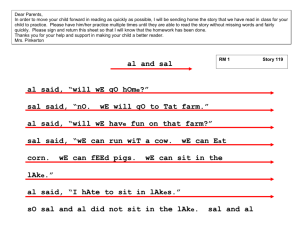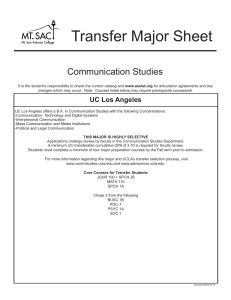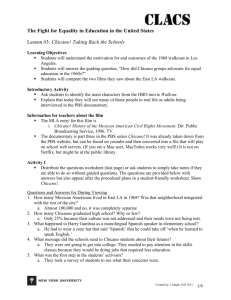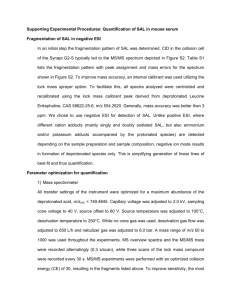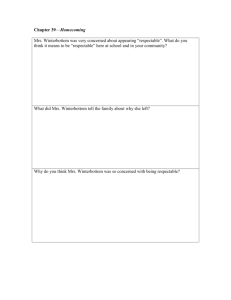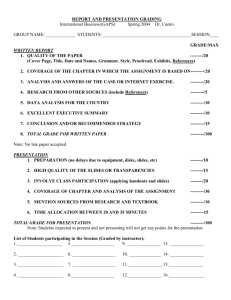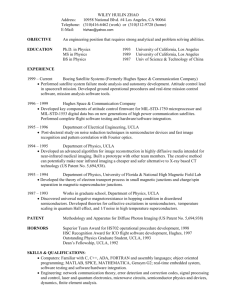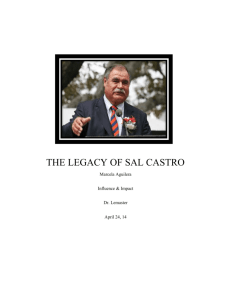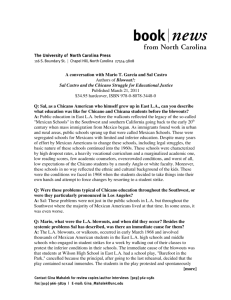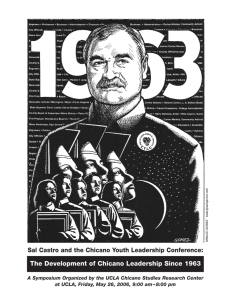Sal Castro's Legacy - the UCLA Chicano Studies Research Center
advertisement
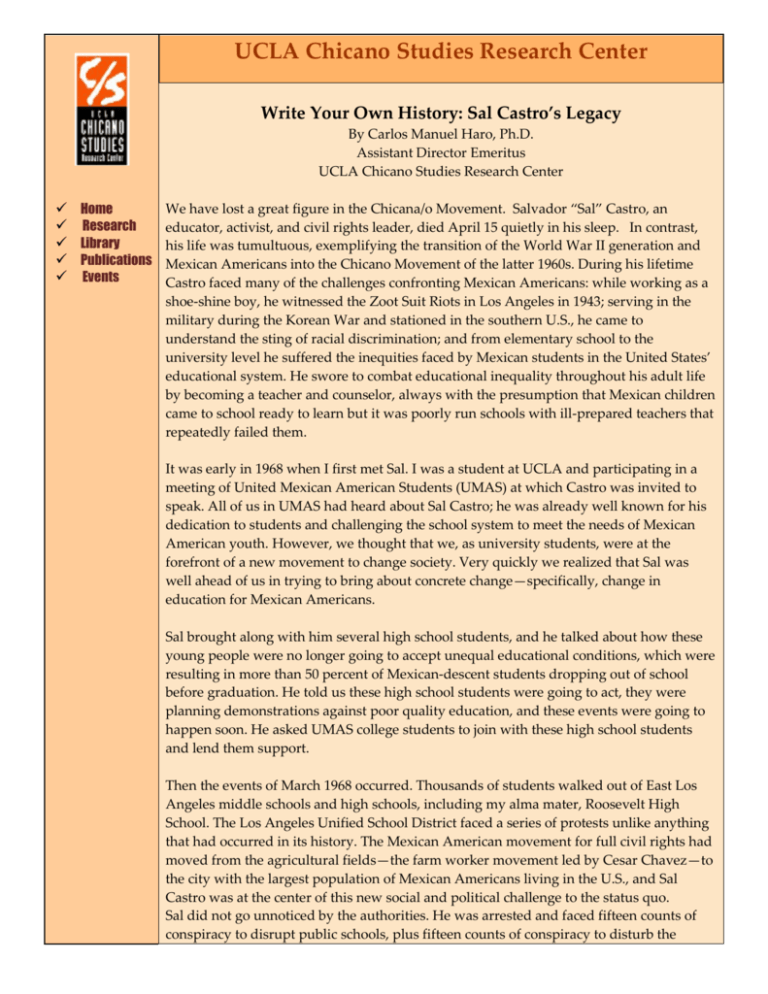
UCLA Chicano Studies Research Center Write Your Own History: Sal Castro’s Legacy By Carlos Manuel Haro, Ph.D. Assistant Director Emeritus UCLA Chicano Studies Research Center Home Research Library Publications Events We have lost a great figure in the Chicana/o Movement. Salvador “Sal” Castro, an educator, activist, and civil rights leader, died April 15 quietly in his sleep. In contrast, his life was tumultuous, exemplifying the transition of the World War II generation and Mexican Americans into the Chicano Movement of the latter 1960s. During his lifetime Castro faced many of the challenges confronting Mexican Americans: while working as a shoe-shine boy, he witnessed the Zoot Suit Riots in Los Angeles in 1943; serving in the military during the Korean War and stationed in the southern U.S., he came to understand the sting of racial discrimination; and from elementary school to the university level he suffered the inequities faced by Mexican students in the United States’ educational system. He swore to combat educational inequality throughout his adult life by becoming a teacher and counselor, always with the presumption that Mexican children came to school ready to learn but it was poorly run schools with ill-prepared teachers that repeatedly failed them. It was early in 1968 when I first met Sal. I was a student at UCLA and participating in a meeting of United Mexican American Students (UMAS) at which Castro was invited to speak. All of us in UMAS had heard about Sal Castro; he was already well known for his dedication to students and challenging the school system to meet the needs of Mexican American youth. However, we thought that we, as university students, were at the forefront of a new movement to change society. Very quickly we realized that Sal was well ahead of us in trying to bring about concrete change—specifically, change in education for Mexican Americans. Sal brought along with him several high school students, and he talked about how these young people were no longer going to accept unequal educational conditions, which were resulting in more than 50 percent of Mexican-descent students dropping out of school before graduation. He told us these high school students were going to act, they were planning demonstrations against poor quality education, and these events were going to happen soon. He asked UMAS college students to join with these high school students and lend them support. Then the events of March 1968 occurred. Thousands of students walked out of East Los Angeles middle schools and high schools, including my alma mater, Roosevelt High School. The Los Angeles Unified School District faced a series of protests unlike anything that had occurred in its history. The Mexican American movement for full civil rights had moved from the agricultural fields—the farm worker movement led by Cesar Chavez—to the city with the largest population of Mexican Americans living in the U.S., and Sal Castro was at the center of this new social and political challenge to the status quo. Sal did not go unnoticed by the authorities. He was arrested and faced fifteen counts of conspiracy to disrupt public schools, plus fifteen counts of conspiracy to disturb the peace. If convicted he would have been in prison the remainder of his life. The school district acted by removing him from the classroom. Ultimately, all charges were dropped and, with strong support from the community, Sal was allowed to teach once again. Fundamental to the 1968 walkouts were the students that Sal was able to mobilize. Many of them had attended the Mexican American Youth Leadership Conference, a three-day event held at Camp Hess Kramer in Malibu, California. Sal first volunteered at the conference in 1963. Before long, however, he had taken it upon himself to change its nature and scope from what he called “a law and order,” and “stay out of trouble” conference to something he felt would be more meaningful to Mexican American youth. Working with students from various high schools, he had them question the educational and social conditions in their schools, and how they perceived themselves. He used to say that students who attended this three-day “camp,” as he often called it, e, were always changed by it: They became secure in their identity and motivated to further educate themselves and be agents for greater change. In fact, it was Castro’s camp graduates who took on leadership roles in planning the 1968 walkouts, including Moctesuma Esparza and Susan Racho, both of whom were UCLA students at the time. Juan Gómez-Quiñones, a UCLA graduate student and now UCLA professor of History, lent support to the walkouts and later helped challenge the LAUSD board when it attempted to dismiss Castro. Racho would later make a documentary on the walkouts (released in 1997), and Esparza became the executive producer, with Edward James Olmos directing, of the 2006 HBO film Walkout. The list of graduates of the Youth Leadership Conference and the college students who volunteered as counselors includes former California State Supreme Court justice Carlos Moreno; Los Angeles Mayor Antonio Villaraigosa; Los Angeles County Supervisor Gloria Molina; as well as Richard Alatorre, Richard Polanco, and many, many other young people whom Castro mentored to become civic leaders, teachers, school administrators, lawyers, and doctors. Some will argue that the demonstrations of 1968 did not cause significant change in the educational system. They will point to the fact that Chicano students are still leaving grade schools at alarmingly high rates. But the walkouts were a seminal event because Castro prompted a dramatic change in the youth, particularly Chicanos in the Los Angeles region. We were no longer ambivalent about our identity, we stood proudly as Chicanos and Chicanas, and we were going to create change in our schools and in other areas of society that affected our communities. The post-walkout period brought a significant increase in student applications and admissions to local colleges, and an array of programs were established to provide financial and academic assistance. Esparza has commented on another change that occurred due to the events of 1968 and the emphasis on education: the stimulation and growth of a Chicano professional class. Sal had a long association with UCLA. Soon after the school district reinstated him to teach, in 1969, he coordinated an Upward Bound Program at UCLA for high school youth. He was also one of the community representatives who supported Movimiento Estudiantil Chicano de Aztlán (MEChA), formerly UMAS, students and our proposal to establish a research center—what became the CSRC. Through the years, Sal and I would periodically meet at social events, but it wasn’t until 2003 that he and I reconnected to work on educational projects. He recruited me—and those who worked with Sal understand what I mean by “recruited”—to annually volunteer as a speaker at the Chicano Youth Leadership Conference. I met with students at the camp and discussed the Mendez v. Westminster case and the long struggle to end school segregation for Mexican youth in California. Sylvia Mendez, after whom the case was named, and Nadine Bermudez, a UCLA doctoral student, joined me. No one was paid; we volunteered our time because Sal asked us to join him, and because the legacy and future of the conference, in addition to its impact, were important to us. In 2004, I interviewed Sal for an oral history project at the CSRC. In 2006 we also collaborated on “Sal Castro and the Chicano Youth Leadership Conference: Developing Chicano Leaders Since 1963,” a significant research conference at UCLA that focused on the camp, the young leaders that emerged from it, and the dramatic events of 1968. Walkout dramatized the 1968 events and Sal Castro’s central role in them. In the film, Castro speaks to students attending his youth leadership camp and asks them to “write your own history.” This was, in fact, how he confronted all of his students. He would say that the history of our people was excluded from the history books, or worse, misrepresented by educators. He challenged students to educate and prepare themselves to make a difference for themselves and their community. Ultimately, Sal Castro succeeded in changing the lives of a generation, and he did indeed write his own history. April 23, 2013 Funeral services for Sal Castro: Rosary - Wednesday, April 24, 7:30 p.m. Our Mother of Good Counsel Church, 2060 N. Vermont Ave., Los Angeles, CA 90027 Funeral Mass - Thursday, April 25, 9:30 a.m. Cathedral of Our Lady of the Angels, 555 W. Temple St., Los Angeles, CA 90012 Further information: http://www.utla.net/castrofuneral
